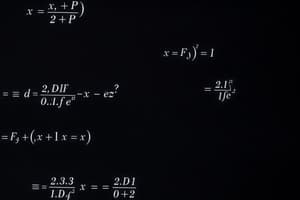Podcast
Questions and Answers
What is the formula for integration by parts?
What is the formula for integration by parts?
- \\[ \int udx = uv - \int v + C \\]
- \\[ \int udv = uv - \int vdu \\] (correct)
- \\[ \int udv = \frac{uv}{v} - \int vdu \\]
- \\[ \int udx = uv - \int vdu \\]
In integration by parts, what does the 'u' and 'v' represent?
In integration by parts, what does the 'u' and 'v' represent?
- 'u' represents a constant, and 'v' represents a variable
- 'u' represents the antiderivative of the function, and 'v' represents a substitution variable
- 'u' represents one of the differentiable functions, and 'v' represents the other differentiable function (correct)
- 'u' represents the antiderivative of the function, and 'v' represents the original function
How does integration by parts help simplify complex integrals?
How does integration by parts help simplify complex integrals?
- It helps reduce complex integrals into simpler ones (correct)
- It helps by breaking down the integral into multiple smaller integrals
- It allows for switching the order of differentiation and integration
- It adds a constant term to the integral to make it easier to solve
What is the key idea behind integration by substitution?
What is the key idea behind integration by substitution?
Which derivative rule is integration by substitution related to?
Which derivative rule is integration by substitution related to?
What is the outcome of integrating common trigonometric, exponential, and logarithmic functions?
What is the outcome of integrating common trigonometric, exponential, and logarithmic functions?
What is the correct substitution to apply for the integral $ \[ \int x e^{x^2} dx \$?
What is the correct substitution to apply for the integral $ \[ \int x e^{x^2} dx \$?
Which of the following is the integral of $ln(2x)$?
Which of the following is the integral of $ln(2x)$?
What is the integral of $cos^3(x)sin(x)$?
What is the integral of $cos^3(x)sin(x)$?
If $f(x) = \int_{0}^{x} e^{t^2} dt$, what property of definite integrals does $f'(x)$ represent?
If $f(x) = \int_{0}^{x} e^{t^2} dt$, what property of definite integrals does $f'(x)$ represent?
What is the integral of $2e^{3x}$?
What is the integral of $2e^{3x}$?
Which integral represents $\int_{1}^{e} \frac{1}{t} dt$?
Which integral represents $\int_{1}^{e} \frac{1}{t} dt$?
Flashcards are hidden until you start studying
Study Notes
Integral Calculus: Exploring Key Formulas and Properties
Integral calculus is an essential branch of mathematics concerned with finding areas under curves or probabilities of events over time. As we delve into this subject matter, four important techniques and concepts emerge: integration by parts, substitution, definite integrals' properties, and integrating common trigonometric, exponential, and logarithmic functions.
Integration By Parts Formula
The integration by parts technique provides us with an antiderivative expression when two differentiable functions (u) and (v') are multiplied together. Its formula is given as:
[ \int udv = uv - \int vdu ]
While finding an appropriate pairing of (u) and (v) may seem challenging at first glance, it helps reduce complex integrals into simpler ones. For instance, consider evaluating (\int xe^x dx.) Here, let (u=x), so (du =dx,) and (v'=e^x), which implies (v=\int e^xdx=e^x). Applying the integration by parts formula yields:
[ \int xe^xdx = x(e^x)-\int e^xdx = xe^x-\int d(e^x)=xe^x-e^x+C]
Integration By Substitution Formula
Related to derivative rules like chain rule, the integration by substitution method lets you transform a given integral into another one involving a new variable (t). Essentially, you substitute (u) for a function of (x): (u = g(x)), where (du = g'(x)dx) and (dt = f'(x)dx). Then, rewrite the original integral using the new variables ((t)) and find its antiderivative. Once again, take the example (\int x\sin(x^2 + 1) dx). To apply the substitution method, choose (u = x^2 + 1 => du = 2x dx). Let (t = u => dt = 2x dx). Now, replace (u) and (dt) in the original integral:
[ \frac{1}{2} \int \sin t , dt = -\cos t + C = -\cos(x^2 + 1) + C]
Definite Integral Properties
Definite integrals involve computing specific intervals rather than arbitrary limits. Some fundamental properties include linearity, monotonicity, summability, and mean value theorem. These properties help solve various real-world problems such as determining the area between graphs and average values.
Trigonometric Function Integrals
Performing integrations of trigonometric functions relies heavily upon their periodic nature. Commonly encountered forms are:
[ \int sinx, dx = -cosx + C ] [ \int cosx, dx = sinx + C]
Furthermore, the following identities can simplify certain expressions:
[ \int sin^nxdx = \frac{-sin^{n-1}x \cdot cosx+(n-1)\int sin^{n-2} x \cdot cos^2 xdx } { n}] [ \int cos^nx, dx = \frac{cos^{n-1}x \cdot sinx-(n-1)\int cos^{n-2} x \cdot sin^2 xdx }{n }]
Exponential and Logarithmic Functions Integrals
For functions containing both exponentials and logs, follow these standard methods:
[ \int e^{ax}, dx = \frac{e^{ax}}{a}+C ] [ \int ln(x), dx = xln|x| - x + C ]
With practices and understanding of these key ideas, mastering integral calculus becomes an achievable goal!
Studying That Suits You
Use AI to generate personalized quizzes and flashcards to suit your learning preferences.




